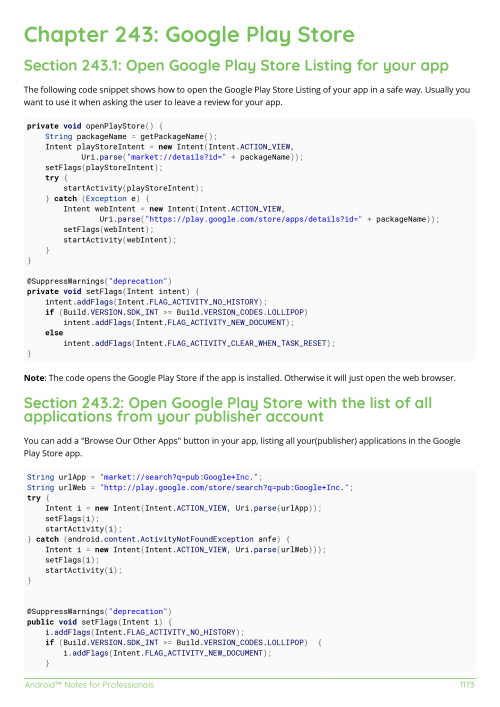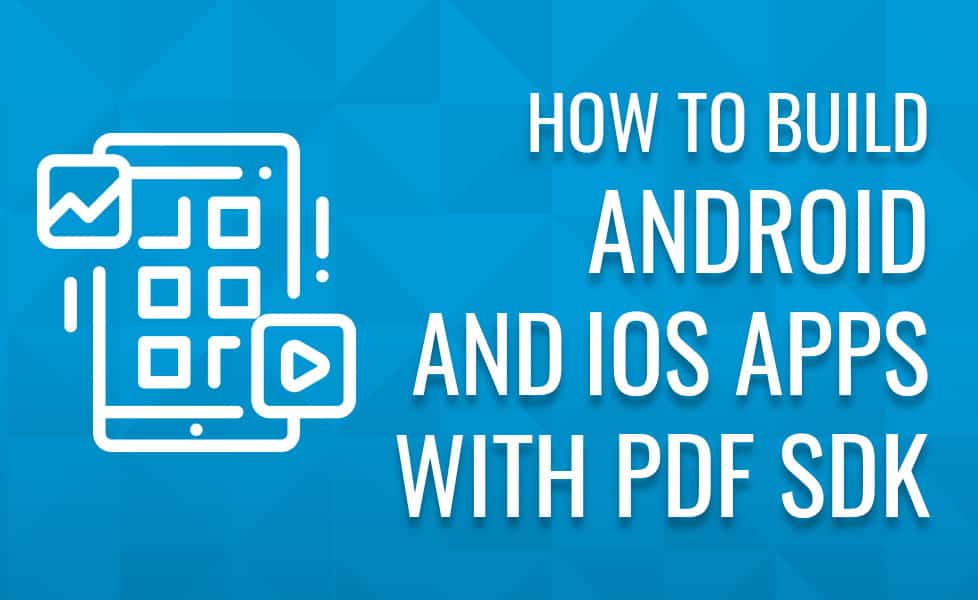Android в„ў Notes for Professionals book
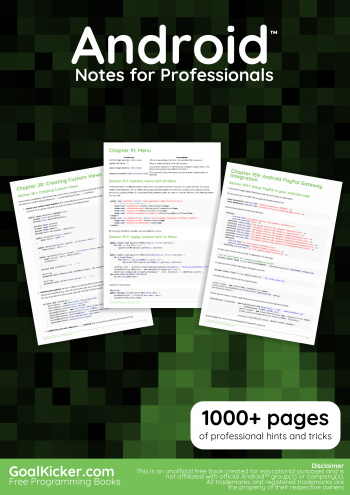
Androidв„ў Notes for Professionals book
If you found this free Androidв„ў book useful,
then please share it ❤рџЉ
Chapters
- Getting started with Android
- Android Studio
- Instant Run in Android Studio
- TextView
- AutoCompleteTextView
- Autosizing TextViews
- ListView
- Layouts
- ConstraintLayout
- TextInputLayout
- CoordinatorLayout and Behaviors
- TabLayout
- ViewPager
- CardView
- NavigationView
- RecyclerView
- RecyclerView Decorations
- RecyclerView onClickListeners
- RecyclerView and LayoutManagers
- Pagination in RecyclerView
- ImageView
- VideoView
- Optimized VideoView
- WebView
- SearchView
- BottomNavigationView
- Canvas drawing using SurfaceView
- Creating Custom Views
- Getting Calculated View Dimensions
- Adding a FuseView to an Android Project
- Supporting Screens With Different Resolutions, Sizes
- ViewFlipper
- Design Patterns
- Activity
- Activity Recognition
- Split Screen / Multi-Screen Activities
- Material Design
- Resources
- Data Binding Library
- SharedPreferences
- Intent
- Fragments
- Button
- Emulator
- Service
- The Manifest File
- Gradle for Android
- FileIO with Android
- FileProvider
- Storing Files in Internal & External Storage
- Zip file in android
- Unzip File in Android
- Camera and Gallery
- Camera 2 API
- Fingerprint API in android
- Bluetooth and Bluetooth LE API
- Runtime Permissions in API-23 +
- Android Places API
- Android NDK
- DayNight Theme (AppCompat v23.2 / API 14+)
- Glide
- Dialog
- Enhancing Alert Dialogs
- Animated AlertDialog Box
- GreenDAO
- Tools Attributes
- Formatting Strings
- SpannableString
- Notifications
- AlarmManager
- Handler
- BroadcastReceiver
- UI Lifecycle
- HttpURLConnection
- Callback URL
- Snackbar
- Widgets
- Toast
- Create Singleton Class for Toast Message
- Interfaces
- Animators
- Location
- Theme, Style, Attribute
- MediaPlayer
- Android Sound and Media
- MediaSession
- MediaStore
- Multidex and the Dex Method Limit
- Data Synchronization with Sync Adapter
- PorterDuff Mode
- Menu
- Picasso
- RoboGuice
- ACRA
- Parcelable
- Retrofit2
- ButterKnife
- Volley
- Date and Time Pickers
- Localized Date/Time in Android
- Time Utils
- In-app Billing
- FloatingActionButton
- Touch Events
- Handling touch and motion events
- Detect Shake Event in Android
- Hardware Button Events/Intents (PTT, LWP, etc.)
- GreenRobot EventBus
- Otto Event Bus
- Vibration
- ContentProvider
- Dagger 2
- Realm
- Android Versions
- Wi-Fi Connections
- SensorManager
- ProgressBar
- Custom Fonts
- Getting system font names and using the fonts
- Text to Speech(TTS)
- Spinner
- Data Encryption/Decryption
- OkHttp
- Handling Deep Links
- Crash Reporting Tools
- Check Internet Connectivity
- Creating your own libraries for Android applications
- Device Display Metrics
- Building Backwards Compatible Apps
- Loader
- ProGuard — Obfuscating and Shrinking your code
- Typedef Annotations: @IntDef, @StringDef
- Capturing Screenshots
- MVP Architecture
- Orientation Changes
- Xposed
- PackageManager
- Gesture Detection
- Doze Mode
- Colors
- Keyboard
- RenderScript
- Fresco
- Swipe to Refresh
- Creating Splash screen
- IntentService
- Implicit Intents
- Publish to Play Store
- Universal Image Loader
- Image Compression
- 9-Patch Images
- Email Validation
- Bottom Sheets
- EditText
- Speech to Text Conversion
- Installing apps with ADB
- Count Down Timer
- Barcode and QR code reading
- Android PayPal Gateway Integration
- Drawables
- TransitionDrawable
- Vector Drawables
- VectorDrawable and AnimatedVectorDrawable
- Port Mapping using Cling library in Android
- Creating Overlay (always-on-top) Windows
- ExoPlayer
- XMPP register login and chat simple example
- Android Authenticator
- AudioManager
- AudioTrack
- Job Scheduling
- Accounts and AccountManager
- Integrate OpenCV into Android Studio
- MVVM (Architecture)
- ORMLite in android
- Retrofit2 with RxJava
- ShortcutManager
- LruCache
- Jenkins CI setup for Android Projects
- fastlane
- Define step value (increment) for custom RangeSeekBar
- Getting started with OpenGL ES 2.0+
- Check Data Connection
- Java on Android
- Android Java Native Interface (JNI)
- Notification Channel Android O
- Robolectric
- Moshi
- Strict Mode Policy : A tool to catch the bug in the Compile Time.
- Internationalization and localization (I18N and L10N)
- Fast way to setup Retrolambda on an android project.
- How to use SparseArray
- Shared Element Transitions
- Android Things
- Library Dagger 2: Dependency Injection in Applications
- JCodec
- Formatting phone numbers with pattern.
- Paint
- What is ProGuard? What is use in Android?
- Create Android Custom ROMs
- Genymotion for android
- ConstraintSet
- CleverTap
- Publish a library to Maven Repositories
- adb shell
- Ping ICMP
- AIDL
- Android game development
- Android programming with Kotlin
- Android-x86 in VirtualBox
- Leakcanary
- Okio
- Bluetooth Low Energy
- Looper
- Annotation Processor
- SyncAdapter with periodically do sync of data
- Fastjson
- JSON in Android with org.json
- Gson
- Android Architecture Components
- Jackson
- Smartcard
- Security
- How to store passwords securely
- Secure SharedPreferences
- Secure SharedPreferences
- SQLite
- Accessing SQLite databases using the ContentValues class
- Firebase
- Firebase Cloud Messaging
- Firebase Realtime DataBase
- Firebase App Indexing
- Firebase Crash Reporting
- Twitter APIs
- Youtube-API
- Integrate Google Sign In
- Google signin integration on android
- Google Awareness APIs
- Google Maps API v2 for Android
- Google Drive API
- Displaying Google Ads
- AdMob
- Google Play Store
- Sign your Android App for Release
- TensorFlow
- Android Vk Sdk
- Project SDK versions
- Facebook SDK for Android
- Thread
- AsyncTask
- Testing UI with Espresso
- Writing UI tests — Android
- Unit testing in Android with JUnit
- Inter-app UI testing with UIAutomator
- Lint Warnings
- Performance Optimization
- Android Kernel Optimization
- Memory Leaks
- Enhancing Android Performance Using Icon Fonts
- Bitmap Cache
- Loading Bitmaps Effectively
- Exceptions
- Logging and using Logcat
- ADB (Android Debug Bridge)
- Localization with resources in Android
- Convert vietnamese string to english string Android
Example book pages
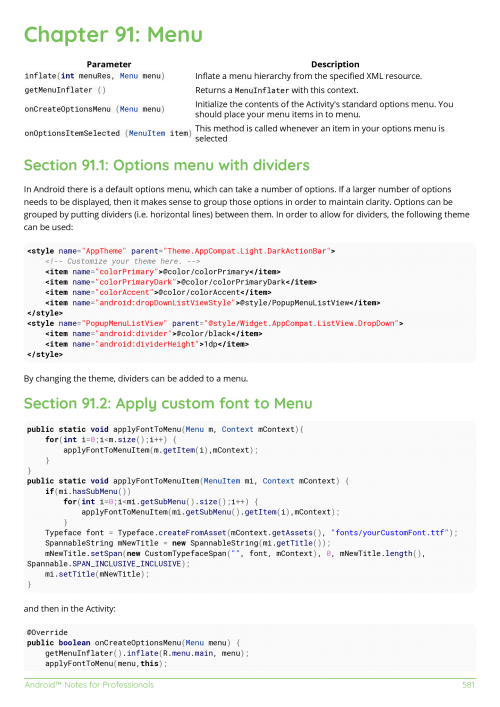
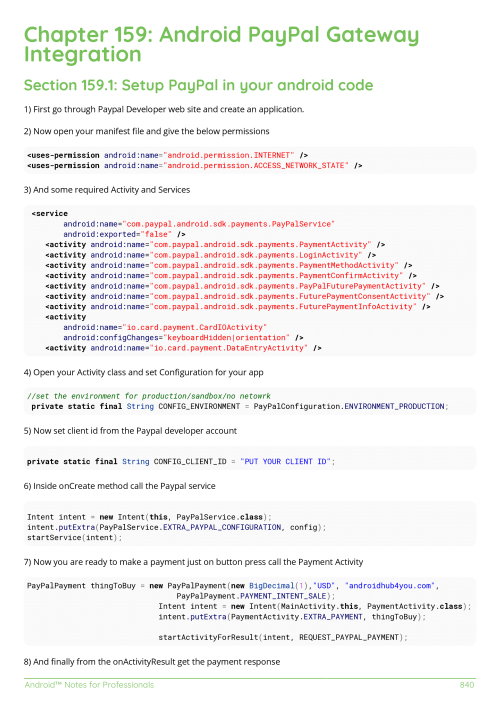
What people are saying about this Androidв„ў Notes for Professionals book
This is amazing. I just downloaded the Android book, and it’s actually pretty good.
It’s really very awesome books for beginners. Thank you
Great buddy. Helpful for all developers! This book covers almost all topics.
Thank you so much for taking the time to make this, really appreciate it !
Awesome tutorial. Apply many techiniques for Dev Android. Thank you!
One of the best resources about Android programming I’ve ever seen and it’s totally free. Thanks!
The Androidв„ў Notes for Professionals book is compiled from Stack Overflow Documentation, the content is written by the beautiful people at Stack Overflow. Text content is released under Creative Commons BY-SA. See credits at the end of this book whom contributed to the various chapters. Images may be copyright of their respective owners unless otherwise specified
Book created for educational purposes and is not affiliated with Androidв„ў group(s), company(s) nor Stack Overflow. All trademarks belong to their respective company owners
Источник
Android apps develop pdf
Developing applications for mobile devices is time-consuming. This is especially true when you need to make them work on both Android and iOS.
App development is crucial to many businesses and is even more popular than websites in some cases. It’s never been more important for mobile app developers to use tools and SDKs that can make advanced functionality available to mobile users. Partnering with companies that understand mobile app development is key.
In order to stay ahead of the competition and be consistent with your customers, mobile apps need to be cross-platform. They must also have the right technologies behind it to run smoothly.
Android and iOS Developers
App developers need high-quality, up to date SDKs to create mobile apps. The mobile development environment (e.g. IDEs, devices, emulators, programming languages, frameworks) changes at a faster rate than desktop and web. This is especially true in the Android and iOS environments, which are the most popular today. Both technologies have grown so much that it’s become a necessity to have a third-party tool like an SDK in order to run small, medium and large applications.
When creating a PDF reader compatible with Android and iOS devices, it’s important to have the option to fully customize the UI. That way, the look and feel of the PDF reader is in line with the rest of the app. Foxit PDF SDK is a great option in this respect. Our technology enables you to easily toggle different features on and off. This includes customizing the style of the UI to match your brand. And all of that without the need to change everything back once we upgrade to a new version. That’s thanks to Foxit PDF SDK’s UI Extensions JSON configuration file. This allows your users to have everything they need at the touch of a button and keeps it that way.
Our Android and iOS PDF libraries are rich in features for app developers. You don’t need to invest in extra SDKs to create a market leading mobile PDF viewer.
Using the likes of Xcode, Visual Studio and Android Studio alongside Foxit PDF SDK, app development can be smooth, seamless and comfortable for both Android and iOS developers.
Kotlin for Android Development
Kotlin is a programming language for Android developers. It was developed by JetBrains, the same group who created Android Studio. Its purpose is to make Android development smoother and more concise through a series of changes to types, nested functions and a few unnecessary declarations for many applications (final classes, open abstract methods, etc).
Our PDF SDK plugs directly into Kotlin so you can easily develop Android apps. The Kotlin language, although newly established, is more secure than Java. This is due to its streamlined handling of null values and checked exceptions. Since 2017, Kotlin is officially supported by Google. It’s built into the Android development toolkit in Android Studio. Because the language interoperates with Java naturally, current Android apps can be slowly brought over to Kotlin from Java without losing functionality. And while a lot of Android apps have already been developed with Java, Kotlin provides the ideal example of where regular updates can lead to more secure and concise applications. This is by steadily moving the development language from Java to Kotlin.
Foxit PDF SDK fully supports Kotlin for Android application development. This means that you don’t need to develop in both Java and Kotlin. As a result, you can develop Android applications that are secure, dependable, and scalable for growth with your users’ needs.
Popular Kotlin Apps
Pinterest, Trello, Evernote, Coursera
Xamarin for Android, iOS and UWP Development
Using Visual Studio, mobile developers can create Xamarin applications in C#. Why develop mobile apps using Xamarin? Because this framework allows mobile developers to create native user interfaces within apps for Android, iOS and UWP devices at the same time.
Xamarin Forms, the cross-platform UI Toolkit, ensures that design layouts are shared across all three platforms but feel native to each individual device. Additionally, the functionality provided by the .NET framework in the background is easy to access through Visual Studio. No need to write a large amount of code to import packages and go through API references all the time to understand the native modules behind your framework.
Using a binding library, Foxit PDF SDK can be integrated into your project seamlessly across all platforms. Using Xamarin.Forms alongside our SDK, mobile app developers can create cross-platform mobile apps with a native PDF viewer. Here, users can annotate, sign and edit without needing to exit the app or install additional software.
Popular Xamarin Apps
Quora, Fox Sport, Highrise, BBC GoodFood
Cordova for Android and iOS Development
Cordova is a platform to develop native mobile apps using HTML5, CSS and JavaScript. Because of the use of web development languages, more developers have the ability to create apps with this platform. Typically, within a Cordova app, the UI is a WebView that is pushed to the native viewing Operating System (OS). If you’re creating a mobile app from a pre-existing web app, it’s relatively easy to do with Cordova. This means that Android and iOS application will have the same UI working smoothly inside different operating systems, even though they were both developed together. There are also a series of plugins you can attach to your Cordova app to make it feel more native. As a free, open source project provided by Apache, many applications are already built on this platform. There are also many resources to help you develop your next mobile app.
To create a Cordova app with Foxit PDF SDK functionality, the SDK needs to be wrapped to ensure that HTML5, CSS and JavaScript work seamlessly. This means that any changes made to the iOS app will be updated on the Android app. This ensures that developers will not have to test functionality on both apps.
Popular Cordova Apps
Pacifica, FanReact, Gudog, Buildr
React Native for Android and iOS Development
React Native is a platform where app developers can create Android and iOS mobile apps for more than one OS at the same time. It also ensures a native design for both platforms through the comprehensive object-oriented architecture to handle UI. This UI was built by the React Native development team at Facebook.
One of the key strengths for React Native is its compiling time. Because it doesn’t need the entire infrastructure of typical mobile environment IDEs, an RN app can run as fast as an HTML/CSS/JS application called from the command line, and still have native functionality. Its flexibility and consistency when declaring and displaying UI elements is a great change from the lengthy DOM processing time in frameworks like jQuery. And still allows developers to reuse code across both OS! Built completely in JavaScript, React Native elements are easily customizable, designed for cross-platform development and 100% community driven.
React Native apps are even more powerful when paired with Foxit PDF SDK. All you will need is node.js and react-native-cli, as well as PDF SDK for both Android and iOS. Our React Native component is the ideal framework for developers who need to integrate PDF technology into their mobile app but who don’t have time to learn native code.
Popular React Native Apps
Uber, Wix, Adidas Glitch and SoundCloud Pulse.
Why Foxit PDF SDK
With Foxit PDF SDK, mobile app development has never been easier. Our PDF libraries are clean and native. We also provide a built-in PDF viewer with our Android and iOS PDF SDK to give mobile app developers a place to start in their project. Our intuitive user interface and code syntax is fluent to the language you are developing in. Our PDF SDK allows developers with limited knowledge to deliver applications to market in a fraction of the time it takes with other SDKs.
Foxit PDF SDK is a future-focused PDF SDK which aims to stay ahead of the curve through integrating with new and emerging technologies. Our development team works around the clock researching, identifying and testing new ways to improve our product all the time. We help our customers have what they need to create a grade A application. Why not try a free trial of our product today and see for yourself.
Источник

